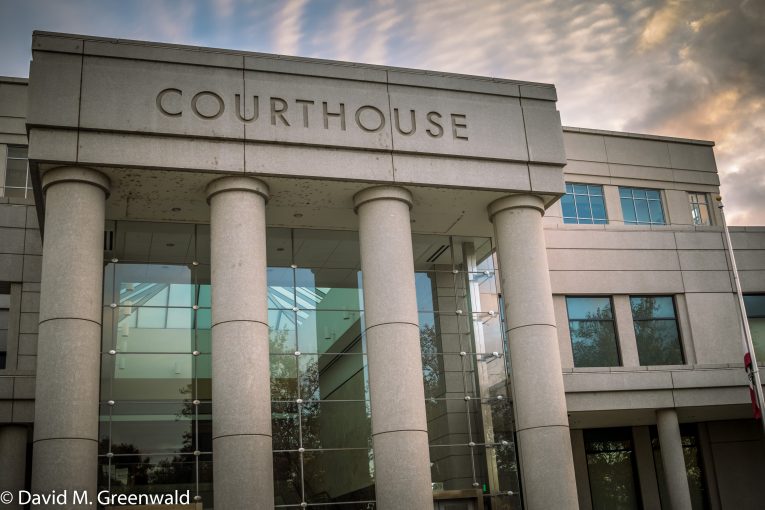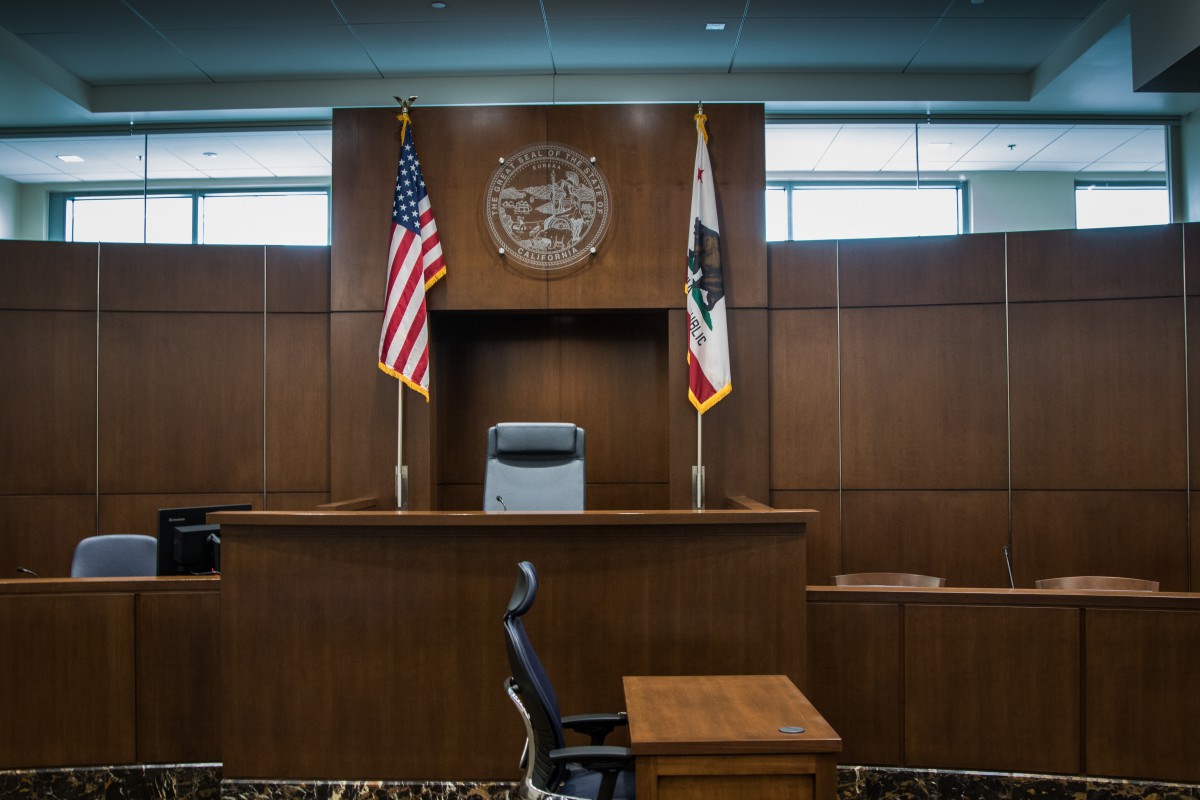

By Samantha Rahn
Woodland – Today we continue with the trial of the People v. Eric Wayne Smith to determine if the defendant is guilty of battery with serious injury.
The court first called upon Dr. Jordan Kramer, the emergency room doctor who treated the alleged victim the night of the assault in question. He established that he is experienced with concussions, estimating that he has likely seen hundreds to thousands in his 33 years of practice.
Dr. Kramer diverged into a brief lesson on concussions, stating that the Glasgow Coma Scale (GCS) is the standard form of assessment. He explained the qualifications for a concussion, stating that not all criteria need to be present and one does not need to lose consciousness. The DA inquired if it would be unlikely not to get a concussion following blunt force trauma. The judge deemed Dr. Kramer an expert in concussions and head injury treatment.
When asked about the evening of April 8, 2019, Dr. Kramer confirmed that he recalls treating the alleged victim. He disclosed that the victim was brought to the hospital with a small superficial laceration next to his eyebrow, complaining only of a headache. Per head injury standards, the doctor ordered a CT scan, which indicated the patient was negative for skull fractures.
The deputy district attorney presented the witness with a photo depicting the patient on the night in question. Upon asking if he thought the laceration, as seen in the picture, would require stitches, he replied, “It depends.” The DA acknowledged the medical report submitted as evidence. Dr. Kramer said that the patient’s discharge diagnosis indicated hypertension and laceration. It is also noted that the patient was instructed to follow the standard head injury protocol.
After confirming that it is possible for symptoms to begin after a trauma, Dr. Kramer added that the duration of symptoms can vary from days to months. If he were to see someone with a laceration, akin to the one in the photo, he would only assume that the person has a concussion if they had mentioned a trauma.
According to the record, the alleged victim was brought to Woodland Memorial Hospital by ambulance at 8:22 pm. Onboard, he had twice told the paramedics that his pain was a zero out of ten. The deputy public defender asked Dr. Kramer to recall his encounter with the patient. The doctor told the court that the victim was responsive, alert, and showed no signs of distress. When describing the symptoms that the alleged victim reported, the doctor said he only complained of a headache. The alleged victim successfully completed the GCS and received a score of 15, the highest score, which suggests a minor head injury.
The medical report indicated that the patient was discharged at 9:58 pm. He appeared to understand the instructions given to him and was able to walk out of the hospital on his own. Dr. Kramer also mentioned that the report notes the patient’s chief complaint was that he had been assaulted at Walters House.
When asked to describe the patient’s laceration, he explained it was a thin superficial cut with a length of one centimeter. Standard treatment would entail dermabond application, followed by steri-strips, which can be removed after one week. He recommended the patient go to a regular physician for a followup since the injury was deemed minor.
The defense then questioned Dr. Kramer about other causes of hypertension, to which he answered alcohol, methamphetamine, and cigarettes. It was then revealed through a social report that the alleged victim told the nurse that he drank three to five beers per week and used methamphetamines one to two times per month.
The defendant’s attorney asked the doctor if the GSC assessments can be misleading. He explained that this is the reasoning behind conducting a CT scan. He was then asked if the patient would still have received the head injury discharge instructions if he had not been informed of the trauma to the head. Dr. Kramer admitted that the patient would have only received instructions for a headache.
The deputy DA once again questioned Dr. Kramer, asking him to reiterate that the laceration is a possible indication of blunt force trauma. Dr. Kramer confirmed this and stated that it is possible to have a concussion without blunt force trauma. He also acknowledged that a GCS score of 15 does not eliminate the possibility of a concussion, because there was blunt force trauma. The prosecution asked if patients can be unaware of their symptoms, to which the doctor explains yes, but in this case, if at any time the patient became disoriented, the nurses would have alerted someone.
As there were no further questions, the court then called the alleged victim to the stand. When asked if he recalled everything from the attack, the alleged victim proclaimed he has a vivid memory of being punched in the face, stumbling backward, and being kicked repetitively by the defendant. The deputy DA asked if he felt tired or exhausted following the attack, to which he responded he felt mostly disoriented and in shock.
The alleged victim walked the court through the afternoon of the incident, explaining that he carried a belt in his hand and proceeded to slap the table with it. He admitted that he approached Mr. Smith, asking him if he “wanted a spank,” and lightly tapped him. After that, the defendant expressed that he was uncomfortable with the situation, so the alleged victim walked away.
The prosecution proceeded to ask the alleged victim to describe his relationship with Mr. Smith. He explained that their friendship began two weeks prior to the incident. The victim likened Mr. Smith to his own son, saying that he tried to mentor him and even gave him money for cigarettes and sodas.
The moment that sparked the brawl involved a pack of cigarettes. As to why the victim tossed a pack of cigarettes toward the defendant, he expressed that he had done so with single cigarettes in the past. This led to the decision to voluntarily flip it to Smith, without his asking for it.
When questioned if he was surprised by Mr. Smith’s reaction, he nodded in agreement, stating he “never saw the punch coming,” and “it was like something had snapped.” According to the alleged victim, he had befriended Mr. Smith. and the two had engaged in joke-telling and playing catch.
The DA then questioned the alleged victim about whether or not it was normal for Walters clients to engage in horseplay, to which he responded yes. He denied ever laying a hand on the defendant prior to the belt incident. Upon being asked if he had been physical with Mr. Smith in any way, he responded, “Absolutely not.” He also informed the court that he walked away after being told to stop by Mr. Smith.
The alleged victim was asked if he still had a scar from the alleged assault. He confirmed the fact, pointing to the small scar situated adjacent to his eyebrow. It was then requested that he walked toward the jury to present his scar.
The deputy public defender reiterated that Mr. Smith became angry after the alleged victim tossed him the pack of cigarettes. She then queried if his response was challenging Smith to a fight. He proclaimed that the defendant came running up to him, to which he verbally responded, “Do what you gotta do.”
She inquired if he agreed with her previous question, as the alleged victim had previously told the officer that he challenged Mr. Smith to a fight. He claimed he does not remember challenging the defendant, however, he does remember the defendant angrily rushing toward him.
The attorney reiterated that he had previously informed the officer that he challenged Mr. Smith and, to this, the alleged victim responded that he does not remember doing so but that it could be true. The deputy public defender went on to say there is a record of his telling the officer that he “should have kept (my) mouth shut.” In response, the alleged victim expressed that he regrets the whole situation.
The defendant’s attorney returned to the cigarette pack in question, beginning with asking the alleged victim if he had cut Mr. Smith off from cigarettes two days prior. The alleged victim confirmed that he did, and shortly thereafter noticed a change in the defendant’s demeanor. When asked if the two were still friendly at that point, he responded that he does not specifically remember, but he is positive that Mr. Smith had been cut off.
Although Mr. Smith was not expecting cigarettes, the alleged victim stated that he knew Mr. Smith liked to smoke and therefore decided to toss the pack to him. The defense asked for clarification as to whether Mr. Smith was looking at the alleged victim before the throw. However, the alleged victim only recalled the defendant catching the pack of cigarettes. The attorney argued that Mr. Smith had been hit in the face with the pack of cigarettes and it must have bounced off before he caught it.
This trial is expected to resume tomorrow at 1:30 pm.





